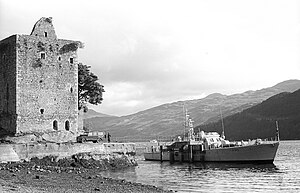Ford-class seaward defence boat
 Droxford at Carrick Castle, Loch Goil 1975
| |
| Class overview | |
|---|---|
| Name | Ford class |
| Builders | Various |
| Operators |
|
| Built | 1950s |
| In service | 1952-1967 |
| Completed | 23 |
| Preserved | HMS Gifford |
| General characteristics | |
| Type | Large patrol craft |
| Displacement |
|
| Length | |
| Beam | 20 ft (6.1 m) [1] |
| Draught | 6 ft 6 in (1.98 m) [1] |
| Propulsion |
|
| Speed | 18 knots (33 km/h; 21 mph)[1] |
| Complement | 19[1] |
| Armament | Depth charge rails with both large and small charges[1] |
The Ford-class seaward defence boats were built for the Royal Navy (with three built for the South African Navy) in the 1950s.
Development
They were designed to detect and attack hostile submarines, including midget submarines in inshore waters such as the approaches to large ports.Bofors 40 mm gun completed the armament.[2]
HMS Droxford served for a time as the tender for Glasgow and Strathclyde Universities Royal Naval Unit, and was administered by RNR Clyde.[1] The vessel was used to train Midshipmen who were students of the universities and participated in fishery protection duties along the west coast of Scotland.[citation needed] HMS Beckford (P3104) was renamed HMS Dee and served as the tender to Liverpool University Royal Naval Unit.[3]
Ships
- HMS Shalford (P3101)
- Kenyan Navyas KNS Nyati
- HMS Axford (P3103) - Transferred to Nigerian Navy as NNS Kaduna
- HMS Beckford (P3104)
- HMS Brayford (P3105) - Transferred to South African Navy, initially as HMSAS Gelderland - Renamed to SAS Gelderland
- HMS Bryansford (P3106) - Transferred to Nigerian Navy as NNS Ibadan II.[4]
- HMS Camberford (P3107)
- Royal Ceylon Navy as HMCyS Kotiya[5]
- HMS Greatford (P3109)
- HMS Gifford (P3111) - Transferred to Nigerian Navy as NNS Bonny
- HMS Droxford (P3113)
- HMS Mayford (P3114)
- HMS Hinksford (P3115) - Transferred to Nigerian Navy as NNS Benin
- HMS Ickford (P3116)
- HMS Dubford (P3119) - Transferred to Nigerian Navy as NNS Sapele
- HMS Glassford (P3120) - Transferred to South African Navy, initially as HMSAS Nautilus - Renamed to SAS Nautilus
- HMS Kingsford (P3121)
- HMS Marlingford (P3122)
- HMS Tilford (P3123) Sold in Singapore 1967.[6]
- Biafran navy as BNS Vigilance. Sunk by Nigerian Navy on 9 October 1967 at Port Harcourt.
- HMSAS Rijger (P3125) - Renamed SAS Rijger
- HMSAS Haerlem (P3126) - Renamed SAS Haerlem
- HMSAS Oosterland (P3127) - Renamed SAS Oosterland
References
- ^ ISBN 0-7106-0774-1.
- ^ a b Gardiner and Chumbley 1995, p. 536.
- ^ a b Blackman 1971, p. 369.
- ISBN 978-1-86176-281-8.
- ISBN 978-1-86176-281-8.
- ^ "HMS Tilford P3123, Builders - Vosper". TON Class Association. Retrieved 20 June 2022.
- Blackman, Raymond V. B. Jane's Fighting Ships 1971–72. London: Sampson Low, Marston & Company, 1971. ISBN 0-354-00096-9.
- Gardiner, Robert and Stephen Chumbley. Conway's All The World's Fighting Ships 1947–1995. Annapolis, Maryland USA: Naval Institute Press, 1995. ISBN 1-55750-132-7.
